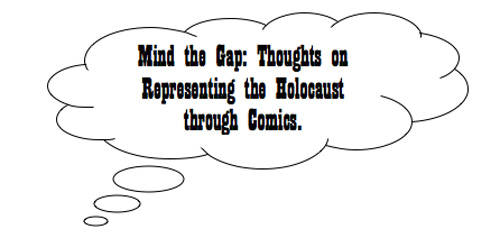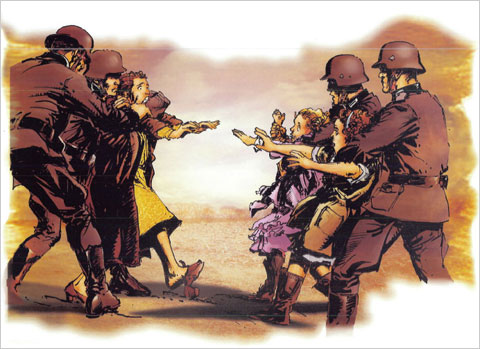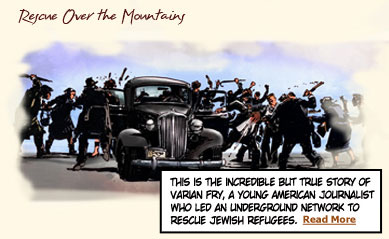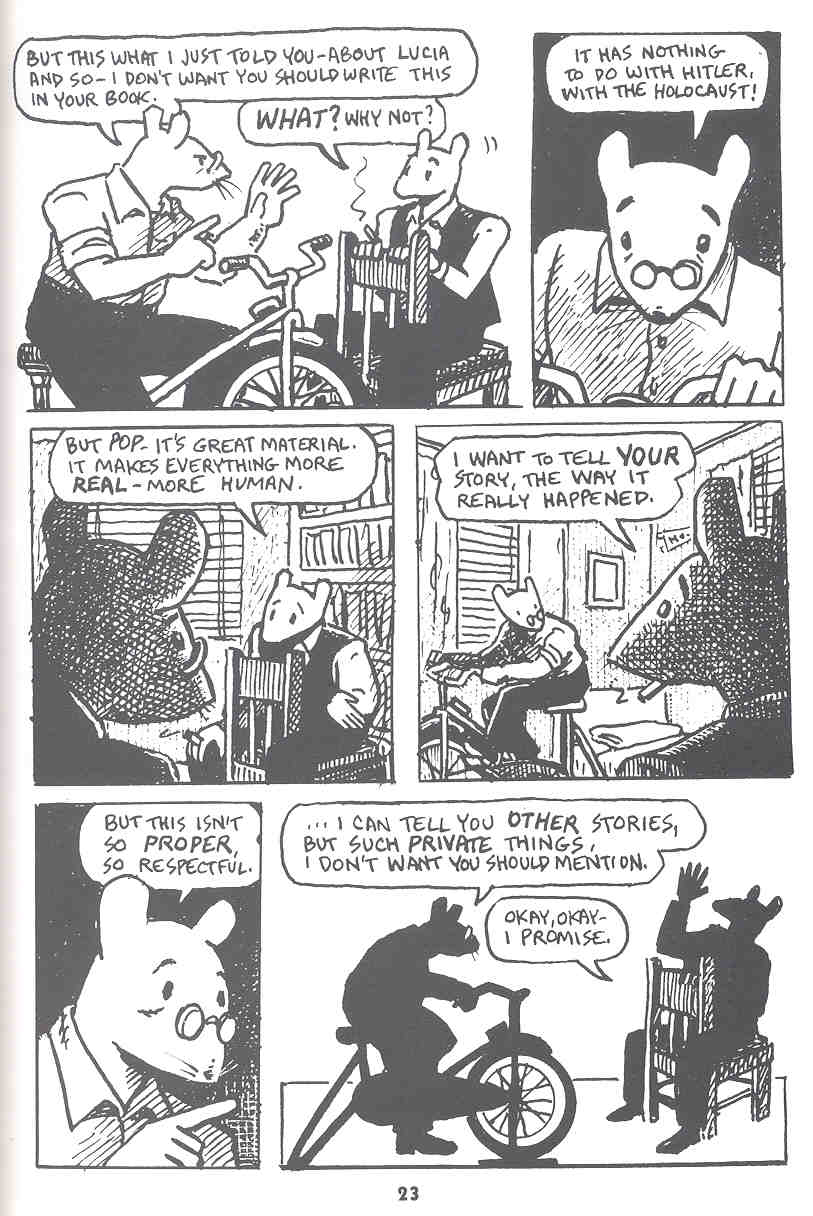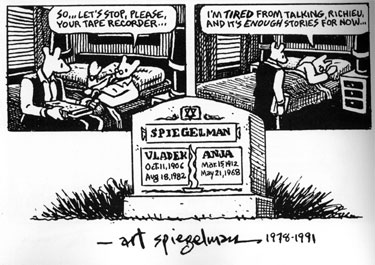The act of codification that is enshrined in the International Declaration of Human Rights has ensured that the unspeakable has been cut down to size at the very moment that it is protested against.
—Theodor Adorno, Minima Moralia, on the UN General Assembly’s defining of the term “genocide.”
This spring marked the launch of an ambitious motion comic series addressing the Holocaust, titled They Spoke Out: American Voices Against the Holocaust. The project, a collaborative effort by comic book artist Neal Adams, Disney Educational Productions, and the David S. Wyman Institute for Holocaust Studies, is a multi-part series, the first volume of which was recently screened by the Museum of Comic and Cartoon Art in New York (and whose initial graphic installments have been made available here). Each episode of this ten-part series aims to chronicle little known stories of heroism by various Americans who spoke out against Fascist extremism or otherwise performed extraordinary acts of bravery, recounting, as the authors of the series put it, the “remarkable stories of Americans of all faiths who raised their voices, marched in protest, or even helped smuggle Jewish refugees out of Hitler’s Europe.”
The mission statement of the series is set forth as follows:
Each year, educators seek new and innovative ways to teach this difficult topic. They Spoke Out: American Voices Against the Holocaust addresses this need by presenting an important but little-known chapter of Holocaust history – and presenting it in a unique and compelling way: through motion comics. Blending the features of comic books, animation, period footage, and photographs, motion comics are the newest, cutting-edge way to entertain and to educate simultaneously.
This graphic project, particularly its artistic strategies and goals as articulated in the above mission statement, inevitably calls to mind and invites comparison to Art Spiegelman’s own two-volume graphic comic project, Maus. A project engaging with the Holocaust, such as They Spoke Out, also raises the question about artistic strategies of representing traumatic events and historical catastrophe, with the prospect that representing catastrophe is fraught with the risk of diminishing the enormity of the represented event, be it the Holocaust or 9/11. Indeed, as Theodor Adorno suggests in the epigraph, codifying catastrophe carries with it the danger of diminishing the specificity and enormity of the historical event. As Alex Thomson has described it, when representations “become a shorthand way of referring to the event and placing it into the continuum of history as such, then the risk is in normalizing and taming the traumatic singularity of any given catastrophe.” (The problem of representing the Holocaust was a subject explored in the Jewish Museum in New York’s controversial 2002 exhibition Mirroring Evil: Nazi Imagery/Recent Art and one of the reasons for the vocal opposition to the exhibition).
While They Spoke Out and Maus both employ a blend of word, graphic images, diagrams, and documentary photographs, they take decidedly different stances toward the catastrophic past. For unlike the straightforward narratives of various historical figures and events in They Spoke Out, Maus is a complicated and deeply personal tale about Spiegelman’s father’s experience in the Holocaust and the author’s own fraught relationship to that traumatic past. Whereas the stories chronicled in They Spoke Out aim to recover for readers heretofore unheralded or forgotten acts of heroism from the historical past through what is essentially a conventional narrative framework—presenting a kind of narrative fullness, if you will—in Spiegelman’s tale, the reader is confronted with certain gaps and discontinuities, which confound the reader’s own process of meaning production.
These challenges to narrative fullness emerge throughout Maus—perhaps most evident in those moments when there is a discrepancy between the words and their accompanying illustration, or in the fragmentary presentation and limited scope of the shifting narrative perspective as the story of Spiegelman’s father, Vladek, unfolds. One of the biggest gaps in Spiegelman’s tale however, is the absence of his deceased mother’s voice, which once it becomes clear that her journals had been destroyed and her story irretrievably lost, leaves a palpable and insistent void at the heart of both Spiegelman’s and the reader’s efforts to reconstruct the traumatic past. Effectively calling into question Spiegelman’s own method of remembering, these disturbances and abruptions in, and to, the narrative function not, or not simply, as representations of the enormous impact and consequences of the father’s traumatic experience, but as symptoms of the author’s own inherited trauma, its disruptive capacity and disordering effects.
Spiegelman’s graphic comic does not so much attend to representing the Holocaust, but to conjuring representation’s incapacity to coalesce around the enormity of such a traumatic event, and his own traumatic relation to that event. Thus, if They Spoke Out employs the comic book’s capacity for hero-formation and affirms the redemptive possibilities of inspirational narratives, Spiegelman uses the medium to gesture to the inadequacy of any narrative—personal or otherwise—to fully master a traumatic past. In this way, Spiegelman’s text resists the “normalizing and taming” trap articulated by Alex Thomson, by instead transmitting an undigested and indigestible trauma that is anything but normalized and tamed. Indeed, any possibility of normalcy and narrative mastery in Maus is dashed in the very last cartoon panel of the book, when Vladek tells his son that he is tired from telling his story and would like to rest, but in so doing calls him not Artie but Richieu, the name of Artie’s brother who died in the war—revealing to the last trauma’s disordering effects.
In closing, it seems fitting to mention one other project that explores the problems that invariably accompany attempts at representing and memorializing the Holocaust: Beryl Korot’s multi-channel video work Dachau, 1974. Dachau, 1974 consists of video footage taken from multiple vantage points during a visit by the artist to Dachau, the notorious Nazi camp, at a time when the camp had been open to the public (Korot described it as an “antiseptic environment inhabited by tourists”). Indeed, as Korot’s video unfolds it becomes a record not of Dachau itself, but rather of tourists interacting with it. In situating Dachau as a symbolic stand in for the Holocaust, Dachau, 1974 ostensibly threatens to veer precisely into the problematic terrain warned against by Adorno and Thomson.
In Korot’s video, however, Dachau, that haunting symbol of an unspeakable catastrophe, becomes just that — a looming presence of an ineffable past. Dachau, 1974, becomes a meditation not so much on the Holocaust itself, but on our mediated and belated relation to that traumatic event, a posterity gestured to in the title of the work, which is of course not Dachau, but Dachau, 1974. And it is here that Dachau, 1974 and Maus might be said to forge a similar stance to a traumatic past distinct from They Spoke Out. After all, the works of Spiegelman and Korot, by transmitting a fragmentary and vicarious relation to a traumatic past rather than simply an explicit narrative of the Holocaust as catastrophic historical event, function as compelling reminders of that unfathomable trauma which resists psychical closure, and one that representation cannot fully decipher.

